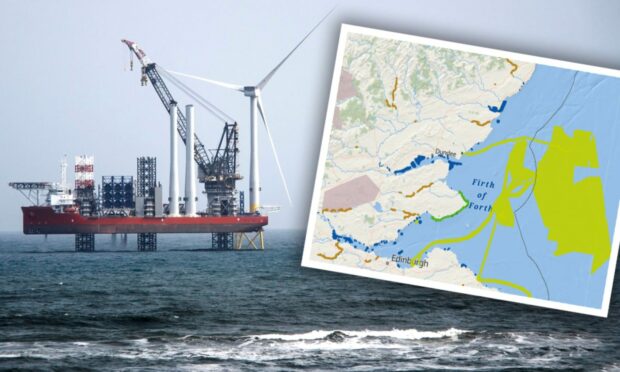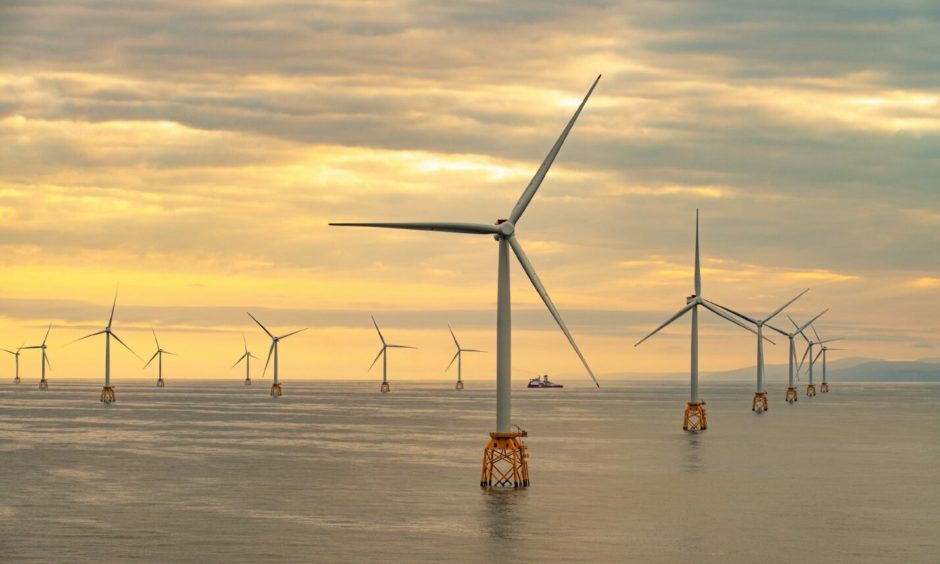Winning bids are to be revealed for swathes of seabed in the outer firths of Tay and Forth for the development of new wind farms capable of powering hundreds of thousands of homes.
Large chunks of the sea bed off the coast of Angus and Fife are up for grabs, with 74 bids submitted by companies competing to win the rights to develop new projects in Scottish waters.
The arrays are expected to create tens of thousands of new jobs in the renewables sector.
The new east coast licences, Marr Bank and Berwick Bank, will build on existing wind farm developments, Neart Na Gaoithe, Inch Cape and Seagreen, which are currently being progressed off the east coast at a cost of several billion pounds.
The extensive development zones fall further east and south of the current developments in the area.
ScotWind organiser Crown Estate Scotland will announce which companies have been successful on Monday, with bids submitted by companies including Shell and BP.
The project is the first round of offshore wind leasing in Scottish waters for a decade.
Once built out, it is hoped the wind farms will generate up to 10GW of energy , enough to power 7.5 million homes.
ScotWind say the project will help Scotland’s reach its net zero target.
“To prevent the most harmful climate change scenarios from coming true, we need to substantially reduce our carbon emissions.
“Scotland’s target is to reach net zero emissions by 2045 – and if we can generate 10GW of new, clean energy from ScotWind projects, it will make a big contribution to reaching that target,” they said.
A maximum bid threshold of £100,000 per square kilometre was put in place.
Energy Voice said this would prompt companies vying for the rights to develop the seabed to “add more strings to their bow” such as spending commitments, supply chain partnerships or job targets.
Sir Jim McDonald, who co-chairs the Scottish Government Energy Advisory Board with First Minister Nicola Sturgeon, said ScotWind presented an enormous international opportunity for Scotland.
Sir Jim predicted up to 5,000 jobs would be created per year during the construction period of the wind farms.
“I think that’s going to be an excellent way to tee Scotland up to serve our own immediate market opportunities through ScotWind, while facing out into what is a growing and ultimately will be an enormous international market opportunity.
“As we build that, we’ve basically got an echo of how the oil and gas industry in Scotland really started 50-60 years ago.
“So we’re focussed on building infrastructure, combining that collaborative industrial community, building strong supply chain and, very importantly, building skills.
“The potential growth here, up to 5,000 jobs being created per annum during construction, around 2,800 jobs during the up to 30-year lifetime of operations.”
Scottish Conservative net zero and energy spokesman Liam Kerr said both Scotland and the North East “have a significant opportunity to be at the forefront of our offshore wind sector in the years ahead”.
The North East MSP said: “As we recover from the pandemic and support the economy, then our renewables sector will have a key role to play.
“However, we have heard many promises on a renewables jobs revolution before under the SNP that simply haven’t come to fruition. As we deliver a just transition towards renewables, we cannot see Ministers squander more opportunities.
“If successful, then this can help secure a positive just transition for the North East, and protect thousands of jobs in the process.”
Orkney and Shetland MP Alistair Carmichael has backed proposals to redevelop the Flotta Terminal in Orkney into one of the world’s first large-scale green hydrogen hubs as part of the leasing round.
If successful, the proposal, called the West of Orkney Windfarm, could deliver renewable power to a green hydrogen production facility at the Flotta Terminal.
Mr Carmichael warned the sea and sea bed in the area are becoming increasingly crowded so any opportunities would bring challenges.
However, he pointed to the existing skills and supply chains from the oil and gas industry as examples of the assets available to help make the project a long-term success.
“Flotta in Orkney and Sullom Voe in Shetland have been massively important to the local economies for 40 years,” Mr Carmichael said.
“We know that oil is on a downward curve now and this looks like a good prospect for Flotta to remain important for who knows how long.”


